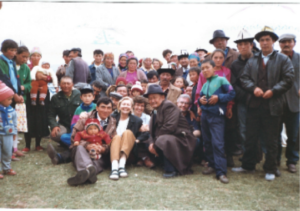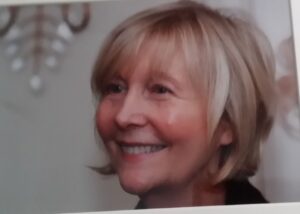by Renee M Earle
The U.S. raised its flag in Alma-Ata in February 1992, the first country to do so after the Republic of Kazakhstan succeeded the Kazakh SSR with the dissolution of the Soviet Union.
Following two years at Embassy Moscow supporting broadcast media throughout the USSR with satellite dishes and new programming as glasnost relaxed control over media, I arrived in Alma-Ata in late summer of 1992 for a new adventure as the first permanent Public Affairs Officer in newly independent Kazakhstan. Under the leadership of Ambassador Bill Courtney and DCM Jackson McDonald, the American diplomatic team pioneering our efforts there was energetic, inventive, and full of can-do spirit. Everything was possible, and a lot was difficult. And, I fell in love with this beautiful country and people.
Where We Worked
Like Kazakhstan itself, embassy transitions were many and came fast. We changed locations three times in those early months as the mission grew quickly. The first chancery was in the “little blue house” on ul. Seyfulina.

We continued some operations, such as secure communications, at the Hotel Kazakhstan, a tall tower sporting a crown, where embassy staff also lived. This arrangement gave way a few months later to a new embassy, a much larger blue house in the former Kazakhstan medical museum.
Public Affairs inherited the original blue house, which we proceeded with great enthusiasm to outfit as a cultural center, the Dom Ameriki. We ordered books and magazines for a small library. All went well until the Kazakh Olympic Committee decided our center would be an ideal headquarters for them now that the U.S. had acquired another embassy building. Afraid of a forced takeover while discussions continued with the Kazakhstani government, our intrepid Kazakh colleagues and I took turns sleeping in the center to prevent a hostile takeover. Policies were changing rapidly in Washington also. The books we had ordered for our library had just arrived when Washington made the unfortunate decision to stop supporting USIS libraries abroad. In the end, we lost our beloved little blue house and moved the public affairs operations into the new embassy building. We donated the books to university libraries, where books, especially about the U.S., were scarce.
Where We Lived
Our living quarters evolved as quickly. We called the Hotel Kazakhstan home for several months while our administrative officers identified apartments throughout the city for the growing staff. The hotel had seen better days and reflected the general state of Soviet neglect and shortages. Heavy smoke had impregnated furniture, walls, and halls. Previous occupants’ cigarette burns pockmarked the red plaid sofa in my shabby-without-the-chic “suite.” Sinking low to the floor, the bed’s mattress would have made a better hammock. Still, there was plenty of heat in winter, something most Soviet buildings assured. The Hotel Kazakhstan sojourn was the only time I remember looking forward to overnight or weekend duty to cover emergencies, including assistance to American citizens or the possible incoming “immediate-action” cable from Washington. Only the communications room had a television and the opportunity to relax with an American video.
We benefitted from the cultural contributions of a substantial Korean minority population in the city. Given the unavailability of cooking in our hotel rooms, the hotel’s Korean restaurant, pretty much the only “show” in town, was where we ate all our dinners. The same Korean dance floor show accompanied the meal every night, and we maintained that we knew the routines so well that we could readily substitute for a dancer who might need a night off.
I was thrilled when I moved to an apartment that afforded a glimpse of the stunning Tian Shan mountains, cooking facilities, and the chance to take advantage of the outdoor markets teeming in summer with mountains of fresh vegetables and berries. Still, when coming home after dark, it was important not to forget a flashlight since the halls had no light bulbs. We never bothered to replace them as the bulbs, subject to the same resource limitations as other areas of Soviet life, would be gone the next morning anyway.
Our Work
In the launch of the first public affairs office, the absence of experienced local staff to guide us in our initial contacts and program history meant everything from press relations to professional and academic changes had to start from zero. Those we usually depend on to be our institutional memory had to be hired and trained. Most educated ethnic Kazakhs spoke Russian professionally and Kazakh at home. Although most of the American embassy team spoke Russian, English was important for embassy operations and communication with Washington. We were fortunate to find excellent English speakers among Kazakhstan’s teachers, who, in record time, became enthusiastic, dedicated—and indispensable —colleagues in all sections of the embassy.
The work was intense and productive, and it often seemed as if months were compacted into days. U.S. visitors, both official and NGO, were non-stop, all interested in supporting the development of this new democracy and economy. While the invasion of western visitors also taxed Kazakhstani resources, we found repeatedly gracious and eager interlocutors everywhere, at the ministries, universities, media, and cultural institutions.
As in the rest of the Soviet Union, direct experience of the U.S. and other western nations was scant in Kazakhstan. A priority therefore was launching as many information and exchange programs as possible to bring Kazakhstanis to the U.S. Some Central Asia experts, given the region’s shared Turkic roots, advocated promoting closer relations with Turkey as the ideal model and intermediary for Central Asian countries in transition. Notwithstanding the contributions Turkey made to these newly independent states, the analysts underestimated the deep and lasting impact of Soviet language, culture, and administration in the region, and they overlooked the fact that these new countries did not necessarily feel they needed an intermediary. They were ready to meet the west themselves. And we did our best to accommodate.
The U.S. 1992 Freedom Support Act brought a huge infusion of funding to aid the former Soviet republics’ transitions. By early 1993, the State Department contingent at Embassy Almaty (formerly known as Alma-Ata), was complemented by a growing number of other agencies and NGOs, from USAID, the Foreign Commercial Service, and the Peace Corps to Internews, the American Bar Association, International Republican Institute, National Democratic Institute, Executive Service Corps, Mercy Corps, and more. Other western visitors were also quickly discovering Central Asia. Those bringing new resources to the country’s tourism development included U.S. extreme skiers who came to test their mettle in the unspoiled Tian Shan mountains.
Academic exchanges were welcomed and plentiful, many carried out by organizations such as the American Consortium of Teachers of Russian. The applicants were numerous, challenging our ability to vet them and at the same time ensure that strongly entrenched bureaucracies could not interfere in the merit-based selection for scholarships.
Among the first Kazakhstani Fulbright scholars, Aida Dossayeva credited her 1992 Fulbright grant in the U.S. for new opportunities in a career that spanned academia and the private sector. Professor of International Economy at the Almaty Institute for National Economy, she taught at the University of Kentucky and guest lectured at North Carolina State University and Duke University. Back in Kazakhstan, she lobbied for the adoption of international business standards and was instrumental to agreements between leading international companies and the Government of Kazakhstan, leaving a lasting impact.
In what we saw as a great vote of confidence in the new U.S.-Kazakhstan relationship, the embassy was asked to assist with drafting Kazakhstan’s new constitution. We brought U.S. legal scholars to work side-by-side with Kazakhstani academics and officials. The group of Kazakhstani supreme court judges we invited to the U.S. through the International Visitor Program to meet with counterparts and see our nation’s institutions at work returned to tell us that if they had not seen it, they could never have imagined the extent of freedom in our political practice and institutions, and that they could now see the same for the future of Kazakhstan.
Cultural Exchange

For an article in the local publication “Dipcourier” (Diplomatic Courier), each embassy section received a set of questions. For Public Affairs, the question was: “Thanks to efforts of the U.S. Embassy workers in Alma-Ata, Kazakhstanis got an opportunity to know more about the U.S. In this connection, we would like to know whether Americans are interested in our life and culture? Do they know anything about us?” Our answer was that we were learning – quickly and eagerly.
American staff and our many visitors took every opportunity to travel and take in the natural beauty and customs of this extraordinary land. We were warmly introduced to Kazakh social life, from the delicacy and significance of sharing a sheep’s head at dinner to local horse races, traditions that were very much alive and recalled Kazakh nomadic history. We involved the embassy in the local community with receptions for young artists and a holiday party for a local orphanage.
Cultural exchange included culinary exchange. As we had been treated to new experiences with Kazakh cuisine, preparing an American-style breakfast for a meeting with Kazakhstan’s political elite and visiting former President Jimmy Carter seemed an appropriate reciprocation. The eggs were local, but the orange juice arrived with the occasional provisions fight from Moscow. And the chefs? Our fellow U.S. diplomats rolled up their sleeves to scramble eggs for two dozen Kazakhstani guests and the president and Rosalynn Carter on several makeshift stoves set up hastily in the basement. I am not sure the breakfast fare was appreciated as much as our encounters with Kazakh delicacies, but our guests enthusiastically engaged with President Carter as he promoted democracy and press freedom in the new states through the Carter Center.

The last 30 years saw Kazakhstan develop economically and in relative stability, but not without challenges of corruption and restrictions on citizen freedoms, vestiges of many years of Soviet rule. Russia has continued as an important influence, and the population of Kazakhstan remains one-sixth ethnic Russian despite significant departures after independence. The U.S. embassy, now in the northern capital of Nur-Sultan, has almost 700 employees, and U.S.-Kazakhstan relations have been broadly and mutually beneficial. As we have learned in the United States, democracy cannot be taken for granted, however, and Kazakhstan’s fragility this year was in full view when peaceful demonstrations turned violent and ended in a swift government crack-down with Russian troop assistance.
At the end of 1993, I was heartbroken to leave Kazakhstan for another assignment. International flights in 1993 left Almaty at 5:00 a.m.; despite the hour, our full Kazakhstani Public Affairs cohort was there to see me off. Thirty years later, I continue to hold high hopes for independent Kazakhstan’s future and the many Kazakhstanis I had the privilege to know.![]()

Renee M. Earle is a retired Public Diplomacy Foreign Service Officer with the rank of Minister-Counselor. She served at embassies in Turkey, USSR/Russia, Kazakhstan, the Czech Republic, France, and the U.S. Mission to the European Union in Brussels. Domestic positions with the Department of State included Diplomat-in-Residence at Duke University in North Carolina, Acting Office Director of Public Diplomacy in the European Bureau, and Chief of the Central Asia Division of the Voice of America, where she directed the Pashto, Dari, Farsi, Uzbek, Azeri, and Turkish language services.
She currently serves as the Publisher of the American Diplomacy Journal.
